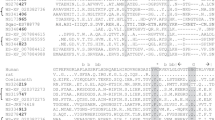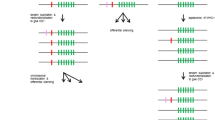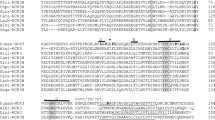Abstract
Natural killer cells are regulated, in part, by cell surface expression of the inhibitory CD94/NKG2A heterodimer and the activating CD94/NKG2C heterodimer. In the present study, we characterize the CD94/NKG2 family in the squirrel monkey, a New World monkey species. Full-length CD94, NKG2A, and NKG2CE complementary deoxyribonucleic acid molecules were identified in three unrelated squirrel monkeys. Three alternatively spliced forms of CD94 were detected in which part of intron 4 was included in the mature transcript, suggesting evolutionary pressure for changes in the corresponding loop 3 region of the lectin domain in squirrel monkeys. Squirrel monkey NKG2A contains a three-nucleotide indel that results in an additional amino acid in the predicted NKG2A protein compared to NKG2A in other species. This NKG2A insertion tracks to loop five of the lectin domain, as is seen with the recently described marmoset NKG2CE indel. Transmembrane-deleted forms of CD94 and NKG2CE were also expressed in the squirrel monkey. Analysis of full-length squirrel monkey and additional primate CD94/NKG2 sequences demonstrated statistically significant increases in the Ka/Ks ratio in the putative major histocompatibility complex E (MHC-E) binding domain compared to the non-binding domain. Furthermore, positive selection was detected in the MHC-E binding domain of primate NKG2 family members, and purifying selection was detected in the primate CD94 binding domain. Purifying selection was also detected in the nonbinding domains of primate CD94 and NKG2 molecules.






Similar content being viewed by others
References
Adamkiewicz TV, McSherry C, Bach FH, Houchins JP (1994) Natural killer lectin-like receptors have divergent carboxy-termini, distinct from C-type lectins. Immunogenetics 39:218
Alvarez M, Martinez-Laso J, Varela P, Diaz-Campos N, Gomez-Casado E, Vargas-Alarcon G, Garcia-Torre C, Arnaiz-Villena A (1997) High polymorphism of Mhc-E locus in non-human primates: alleles with identical exon 2 and 3 are found in two different species. Tissue Antigens 49:160–167
Averdam A, Kuhn H, Sontag M, Becker T, Hughes AL, Reinhardt R, Walter L (2007) Genomics and diversity of the common marmoset monkey NK complex. J Immunol 178:7151–7161
Birch J, Ellis SA (2007) Complexity in the cattle CD94/NKG2 gene families. Immunogenetics 59:273–280
Borrego F, Ulbrecht M, Weiss EH, Coligan JE, Brooks AG (1998) Recognition of human histocompatibility leukocyte antigen (HLA)-E complexed with HLA class I signal sequence-derived peptides by CD94/NKG2 confers protection from natural killer cell-mediated lysis. J Exp Med 187:813–818
Boyington JC, Riaz AN, Patamawenu A, Coligan JE, Brooks AG, Sun PD (1999) Structure of CD94 reveals a novel C-type lectin fold: implications for the NK cell-associated CD94/NKG2 receptors. Immunity 10:75–82
Boyington JC, Raiz AN, Brooks AG, Patamawenu A, Sun PD (2000) Reconstitution of bacterial expressed human CD94: the importance of the stem region for dimer formation. Protein Expr Purif 18:235–241
Braud V, Jones EY, McMichael A (1997) The human major histocompatibility complex class Ib molecule HLA-E binds signal sequence-derived peptides with primary anchor residues at positions 2 and 9. Eur J Immunol 27:1164–1169
Carretero M, Cantoni C, Bellon T, Bottino C, Biassoni R, Rodriguez A, Perez-Villar JJ, Moretta L, Moretta A, Lopez-Botet M (1997) The CD94 and NKG2-A C-type lectins covalently assemble to form a natural killer cell inhibitory receptor for HLA class I molecules. Eur J Immunol. 27:563–567
Carretero M, Palmieri G, Llano M, Tullio V, Santoni A, Geraghty DE, Lopez-Botet M (1998) Specific engagement of the CD94/NKG2-A killer inhibitory receptor by the HLA-E class Ib molecule induces SHP-1 phosphatase recruitment to tyrosine-phosphorylated NKG2-A: evidence for receptor function in heterologous transfectants. Eur J Immunol 28:1280–1291
Chang C, Rodriguez A, Carretero M, Lopez-Botet M, Phillips JH, Lanier LL (1995) Molecular characterization of human CD94: a type II membrane glycoprotein related to the C-type lectin superfamily. Eur J Immunol 25:2433–2437
Chiang HI, Zhou H, Raudsepp T, Jesudhasan PR, Zhu JJ (2007) Chicken CD69 and CD94/NKG2-like genes in a chromosomal region syntenic to mammalian natural killer gene complex. Immunogenetics 59:603–611
Furukawa H, Yabe, T, Watanabe K, Miyamoto R, Akaza T, Tadokoro K, Tohma S, Inoue T, Yamamoto K, Juji T (1998) An alternatively spliced form of the human CD94 gene. Immunogenetics 48:87–88
Geraghty DE, Daza R, Williams LM, Vu Q, Ishitani A (2002) Genetics of the immune response: identifying immune variation within the MHC and throughout the genome. Immunol Rev 190:69–85
Glienke J, Sobanov Y, Brostjan C, Steffens C, Nguyen C, Lehrach H, Hofer E, Francis F (1998) The genomic organization of NKG2C, E, F, and D receptor genes in the human natural killer gene complex. Immunogenetics 48:163–173
Graur D, Li W (2000) Fundamentals of molecular evolution, 2nd edn. Sinauer, Sunderland, MA
Houchins JP, Yabe T, McSherry C, Miyokawa N, Bach FH (1990) Isolation and characterization of NK cell or NK/T cell-specific cDNA clones. J Mol Cell Immunol 4:295–306
Houchins JP, Yabe T, McSherry C, Bach FH (1991) DNA sequence analysis of NKG2, a family of related cDNA clones encoding type II integral membrane proteins on human natural killer cells. J Exp Med 173:1017–1020
Houchins JP, Lanier LL, Niemi EC, Phillips JH, Ryan JC (1997) Natural killer cell cytolytic activity is inhibited by NKG2-A and activated by NKG2-C. J Immunol 158:3603–3609
Hughes AL, Nei M (1988) Pattern of nucleotide substitution at major histocompatibility complex class I loci reveals overdominant selection. Nature 335:167–170
Hughes AL, Nei M (1989) Nucleotide substitution at major histocompatibility complex class II loci: Evidence for overdominant selection. Proc Natl Acad Sci USA 86:958–962
Hughes AL (2002) Natural selection and the diversification of vertebrate immune effectors. Immunol Rev 190:161–168
Hurst LD (2002) The Ka/Ks ratio: diagnosing the form of sequence evolution. Trends Genet 18:486–487
Kabat J, Borrego F, Brooks A, Coligan JE (2002) Role that each NKG2A ITIM plays in mediating the human CD94/NKG2A inhibitory signal. J Immunol 169:1948–1958
Kaiser BK, Barahmand-pour F, Paulsene W, Medley S, Geraghty DE, Strong RK (2005) Interactions between NKG2. . immunoreceptors and HLA-E ligands display overlapping affinities and thermodynamics. J Immunol 174:2878–2884
Knapp LA, Cadavid LF, Watkins DI (1998) The MHC-E locus is the most well conserved of all known primate class I histocompatibility genes. J Immunol 160:189–196
LaBonte ML, Levy DB, Letvin NL (2000) Characterization of rhesus monkey CD94/NKG2 family members and identification of novel transmembrane-deleted forms of NKG2-A, B, C, and D. Immunogenetics 51:496–499
LaBonte ML, Choi EI, Letvin NL (2004a) Molecular determinants regulating the pairing of NKG2 molecules with CD94 for cell surface heterodimer expression. J Immunol 172:6902–6912
LaBonte ML, Letvin NL (2004b) Variable NKG2 expression in the peripheral blood lymphocytes of rhesus monkeys. Clin Exp Immunol 138:205–212
Lafont BA, Buckler White A, Plishka R, Buckler C, Martin MA (2004) Pig-tailed macaques (Macaca nemestrina) possess six MHC-E families that are conserved among macaque species: implication for their binding to natural killer receptor variants. Immunogenetics 56:142–154
Lanier LL, Corliss B, Wu J, Phillips JH (1998a) Association of DAP12 with activating CD94/NKG2C NK cell receptors. Immunity 8:693–701
Lanier LL, Corliss BC, Wu J, Leong C, Phillips JH (1998b) Immunoreceptor DAP12 bearing a tyrosine-based activation motif is involved in activating NK cells. Nature 391:703–707
Lazetic S, Chang C, Houchins JP, Lanier LL, Phillips JH (1996) Human natural killer cell receptors involved in MHC class I recognition are disulfide-linked heterodimers of CD94 and NKG2 subunits. J Immunol 157:4741–4745
Le Drean E, Vely F, Olcese L, Cambiaggi A, Guia S, Krystal G, Gervois N, Moretta A, Jotereau F, Vivier E (1998) Inhibition of antigen-induced T cell response and antibody-induced NK cell cytotoxicity by NKG2A: association of NKG2A with SHP-1 and SHP-2 protein-tyrosine phosphatases. Eur J Immunol 28:264–276
Lieto LD, Maasho K, West D, Borrego F, Coligan JE (2006) The human CD94 gene encodes multiple, expressible transcripts including a new partner of NKG2A/B. Genes Immun 7:36–43
Lohwasser S, Hande P, Mager DL, Takei F (1999) Cloning of murine NKG2A, B and C: second family of C-type lectin receptors on murine NK cells. Eur J Immunol 29:755–761
Low PJ, Ai R, Ogata RT (1999) Active sites in complement components C5 and C3 identified by proximity to indels in the C3/4/5 protein family. J Immunol 162:6580–6588
Lynch KW (2004) Consequences of regulated pre-mRNA splicing in the immune system. Nature Rev Immunol 4:931–940
Messer PW, Arndt PF (2007) The majority of recent short DNA insertions in the human genome are tandem duplications. Mol Biol Evol 24:1190–1197
Miller JD, Weber DA, Ibegbu C, Pohl J, Altman JD, Jensen PE (2003) Analysis of HLA-E peptide-binding specificity and contact residues in bound peptide required for recognition by CD94/NKG2. J Immunol 171:1369–1375
Nielsen R (2005) Molecular signatures of positive selection. Annu Rev Genet 39:197–218
Ogata RT, Low PJ (1997) Complement-inhibiting peptides identified by proximity to indels in the C3/4/5 protein family. J Immunol 158:3852–3860
Ogata RT, Ai R, Low PJ (1998) Active sites in complement component C2 mapped by mutations at indels. J Immunol 161:4785–4794
Plougastel B, Jones T, Trowsdale J (1996) Genomic structure, chromosome location, and alternative splicing of the human NKG2A gene. Immunogenetics 44:286–291
Riordan JR, Rommens JM, Kerem B, Alon N, Rozmahel R, Grzelczak Z, Zielenski J, Lok S, Plavsic N, Chou JL et al (1989) Identification of the cystic fibrosis gene: cloning and characterization of complementary DNA. Science 245:1066–1073
Rodriguez A, Carretero M, Glienke J, Bellon T, Ramirez A, Lehrach H, Francis F, Lopez-Botet M (1998) Structure of the human CD94 C-type lectin gene. Immunogenetics 47:305–309
Rozas J, Sánchez-DelBarrio JC, Messeguer X, Rozas R (2003) DnaSP, DNA polymorphism analyses by the coalescent and other methods. Bioinformatics 19:2496–2497
Shum BP, Flodin LR, Muir DG, Rajalingam R, Khakoo SI, Cleland S, Guethlein LA, Uhrberg M, Parham P (2002) Conservation and variation in human and common chimpanzee CD94 and NKG2 genes. J Immunol 168:240–252
Tomasello E, Bléry M, Vély E, Vivier E (2000) Signaling pathways engaged by NK cell receptors: double concerto for activating receptors, inhibitory receptors and NK cells. Semin Immunol 12:13–147
Ulbrecht M, Modrow S, Srivastava R, Peterson PA, Weiss EH (1998) Interaction of HLA-E with peptides and the peptide transporter in vitro: implications for its function in antigen presentation. J Immunol 160:4375–4385
Vance RE, Jamieson AM, Raulet DH (1999) Recognition of the class Ib molecule Qa-1b by putative activating receptors CD94/NKG2C and CD94/NKG2E on mouse natural killer cells. J Exp Med 190:1801–1812
Wada H, Matsumoto N, Maenaka K, Suzuki K, Yamamoto K (2003) The inhibitory NK cell receptor CD94/NKG2A and the activating receptor CD94/NKG2C bind the top of HLA-E through mostly shared but partly distinct sets of HLA-E residues. Eur J Immunol 34:81–90
Wetterbom A, Sevov M, Cavelier L, Bergström TF (2006) Comparative genomic analysis of human and chimpanzee indicates a key role for indels in primate evolution. J Mol Evol 63:682–692
Wooden SL, Kalb SR, Cotter RJ, Soloski MJ (2005) Cutting edge: HLA-E binds a peptide derived from the ATP-binding cassette transporter multidrug resistance-associated protein 7 and inhibits NK cell-mediated lysis. J Immunol 175:1383–1387
Acknowledgments
This work was supported in part by a Bridgewater State College CART FLRG grant (M.L.), a LI-COR Genomics Education Matching Fund Program grant (M.L.), three Bridgewater State College ATP semester grants (J.R and S.F.), and the Bridgewater State College Biology Department. We would like to thank Dr. Jason LaBonte for careful review of the manuscript and Dr. Christopher Bloch for help with the statistical analysis.
Author information
Authors and Affiliations
Corresponding author
Rights and permissions
About this article
Cite this article
LaBonte, M.L., Russo, J., Freitas, S. et al. Variation in the ligand binding domains of the CD94/NKG2 family of receptors in the squirrel monkey. Immunogenetics 59, 799–811 (2007). https://doi.org/10.1007/s00251-007-0249-z
Received:
Accepted:
Published:
Issue Date:
DOI: https://doi.org/10.1007/s00251-007-0249-z




